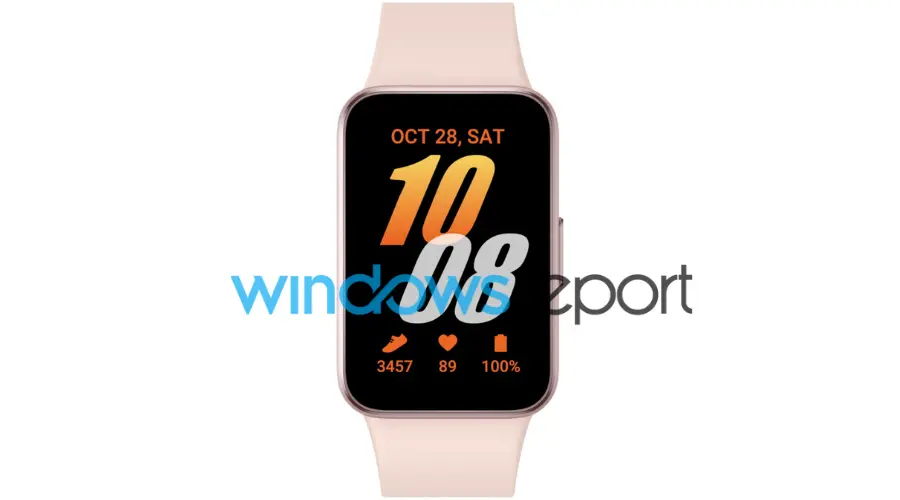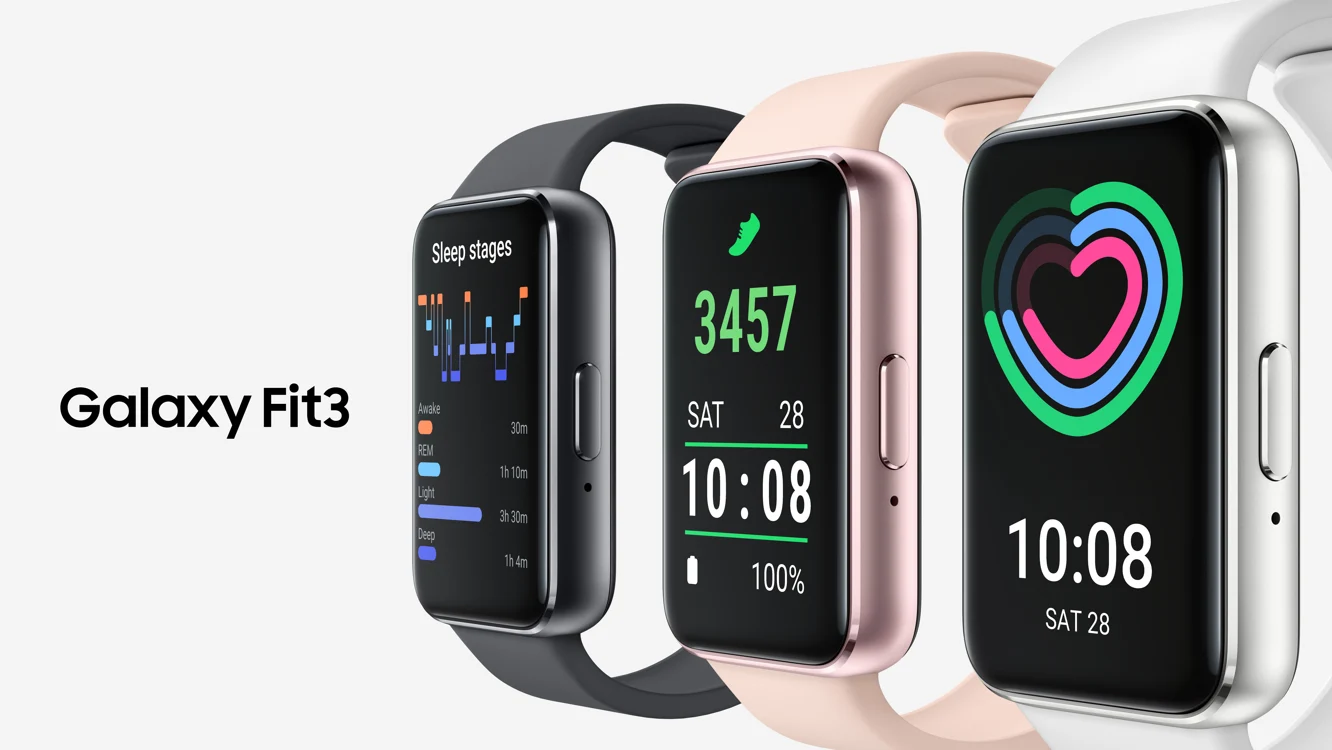Accessories
Samsung Galaxy Fit 3: The next-gen fitness tracker that’s more like a smartwatch

Soon, there might be a new Samsung Galaxy Fit 3 fitness tracker. As per the leaked photos of the purported smart gadget by WindowsReport today, it has a new appearance for the series and appears to have a significantly improved screen. So far, it is able to analyze only a few pieces of information about the gadget. Three years is a long time in the consumer technology world; this was the actual time that the Galaxy Fit 2 was launched. Though it is unconfirmed of the Galaxy Fit 3’s operating system, the pictures reveal a new watchface.
Although Samsung is more likely to remain with more basic fitness tracker software, such as its earlier RTOS, it is feasible that the firm may integrate Wear OS. Its predecessor, the Galaxy Fit 2, was launched as a low-cost tracker with a 1.1-inch AMOLED-colored screen, which offered the advantages of 50 meters of water resistance and 15 days of battery life.

What’s new with the Galaxy Fit 3?
- This time, the Fit 3 model is getting a bigger screen with the same AMOLED display.
- A heart rate monitor sensor and docking connectors are also visible on the rear part of the Galaxy Fit 3.
- Fit 3 may have a GPS sensor, which the Fit 2 lacked; however, it has a thinner appearance than the later.
- A built-in memory for storing and stand-alone music playback while the device is not linked to the phone is possible.
- With the Galaxy Fit 3 tracker, you cannot change the color of your wristband, as with the Fit 2 tracker. So the users need to stick with the color that they purchase.
There are a few tiny openings on the inside of the watch band that go parallel to the top of the Samsung Fit 3. Those could be buttons to more easily release the springs, like the ones Samsung added to the Watch 6. On the other hand, they could provide respite from perspiration and let air flow through while exercising. The upcoming tracker may have an extended battery life—longer than 15 days of battery life.

Galaxy Fit 3’s Cost and Release:
Back in 2020, the Galaxy Fit 2 was launched with a price range of $59; however, time flies, and for sure, the Fit 3 tracker will be quite expensive. Samsung introduces its fitness tracker every time, along with smartphones. As it is expected that the Galaxy Fit 3 will launch somewhere around 2024, there are high chances that it will debut with the Galaxy S24 series.

Accessories
Samsung Galaxy Fit 3 Receives First Software Update

The Samsung Galaxy Fit 3 was launched back in February. This watch is built differently from the other Galaxy watchesto delicately fit a fitness band that is lightweight and suitable for tracking sleep, stress, heart rate, and activities like walking, running, and cycling. It doesn’t support other entertainment features like Galaxy watches. To ensure seamless functioning, the company has started rolling out new updates.
Galaxy Fit 3 updates: What’s new?
The Samsung Galaxy Fit3 is getting a new update with the firmware version number R390XXU0AXE1. The update is currently spotted in South Korea and is expected to expand to more regions in the next few days. With the latest update, the company hasn’t introduced any significant features, but the changelog says that it will apply some new security codes, which indicates that the update will improve the overall security of the devices.

Installation
To update the Galaxy Fit 3, follow these simple steps below:
- Open the Galaxy wearable app.
- Tap band settings,
- Now scroll down and tap Band Software Update.
- Now choose the option of wi-fi or mobile data to download.
- Next, click on download and install.
Follow Sam Lover on Your Favorite Social Media Platforms
Accessories
Samsung Tizen OS Brings New AI for TVs: Enhancing Visual Experience

Samsung introduced its latest AI TV, Neo QLED 8K QN900D, coupled with advanced technologies for enhancing the viewing experience.
Samsung has powered the latest AI TV with its most efficient and powerful processor, the 8K NQ8 AI Gen3 Processor, as well as a neural processing unit (NPU) that runs twice as fast as its predecessor. This new AI TV features eight times as many neural networks—512 instead of 64. It analyzes and optimizes content in real-time, capable of delivering superior picture and sound quality and elevating the TV experience to one that places viewers at the center.

8K AI Upscaling Pro and AI Motion Enhancer Pro deliver high-end clarity by sharpening low-resolution content and minimizing ball distortion and blurring. Samsung adds Active Voice Amplifier Pro to distinguish between voice and background noise.

While watching any show on TV, the Object Tracking Sout (OTS) Pro, viewers are no longer spectators. The AI Optimization automatically fine-tunes the settings for the best viewing experience, and the AI Auto Game Mode helps to recognize game titles and genres and automatically optimizes settings for an upgraded experience.

AI Energy Mode conserves energy by using sensors to analyze ambient lighting before automatically adjusting the AI TV screen’s brightness. The Samsung Tizen OS changed the AI TV into more than an entertainment center.

Samsung’s AI TV continues to grow to do just that by pushing the frontier of audio as well as visual experience and upgrading sustainability while putting AI to work under the hood.
Accessories
Samsung Electronics Rank First In Global OLED Monitor Market

Samsung Electronics is a mastermind in the display industry and rarely sacrifices to maintain its legacy. Now it has secured the top position in global sales of OLED monitors, one year after debuting its first OLED model.
A year ago, Samsung introduced its first OLED model, the 34-inch Odyssey OLED g8 (G85SB model), a gaming monitor. As per the metrics of International Data Corporation (IDC), Samsung Electronics has taken the top position in the global OLED monitor market by securing 34.7% of the market share based on overall revenue and the leading position in market share based on sales volume, with 28.3% of OLED monitors sold last year.
The Executive Vice President of Visual Display Business at Samsung Electronics stated, “This achievement speaks to our drive for excellence and understanding of consumer needs, the key factors in producing outstanding OLED monitors for performance-demanding gamers around the globe.”
The Korean giant also led the overall global gaming monitor market for the fifth consecutive year, recording a market share of 20.8% in total revenue. Since entering the OLED market, the company has continued to initiate and receive praise for new monitors, including the Odyssey OLED G9 (G95SC model), which received widespread acclaim from experts and reviewers worldwide.
Samsung reveals an expansion of its OLED monitor series at CES 2024 by debuting three new products:
- The Odyssey OLED G8 (G80SD model) features a 32-inch 4K UHD resolution, a 16:9 aspect ratio, a refresh rate of 240 Hz, and a 0.03 ms response time (GtG).
- The Odyssey OLED G6 (G60SD model), along with a 27-inch QHD resolution, a 16:9 aspect ratio, a refresh rate of 360 Hz, and a 0.03 ms response time (GtG),
- An updated Odyssey OLED G9 (G95SD model) with 49-inch dual QHD resolution in a 32:9 aspect ratio, a refresh rate of 240Hz, 0.03 ms response time (GtG), and new features.
The giant will continue to expand its gaming monitor series by introducing new Odyssey OLED models, each of which will leverage Samsung’s proprietary OLED technology.












